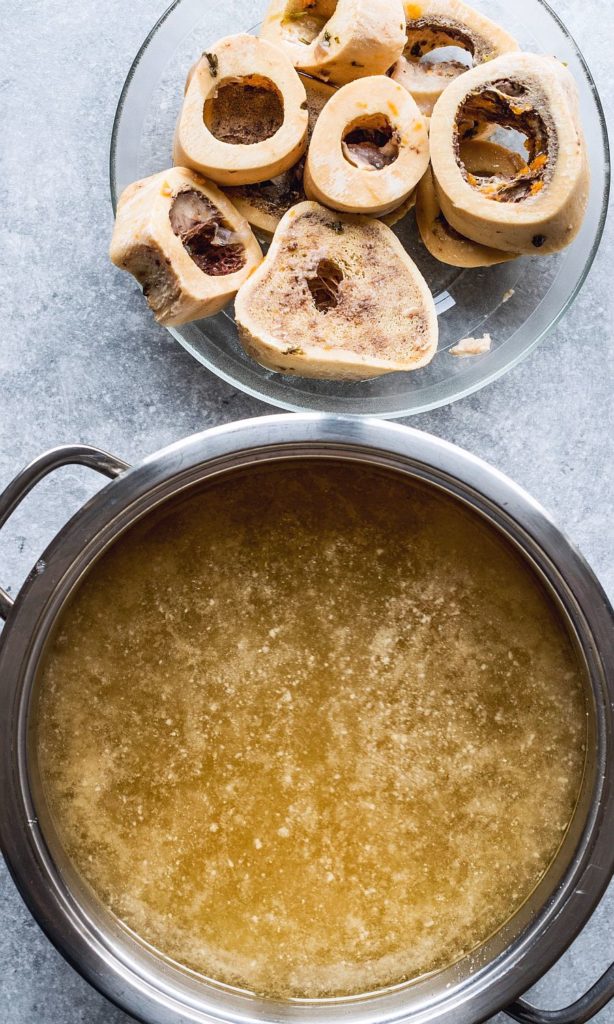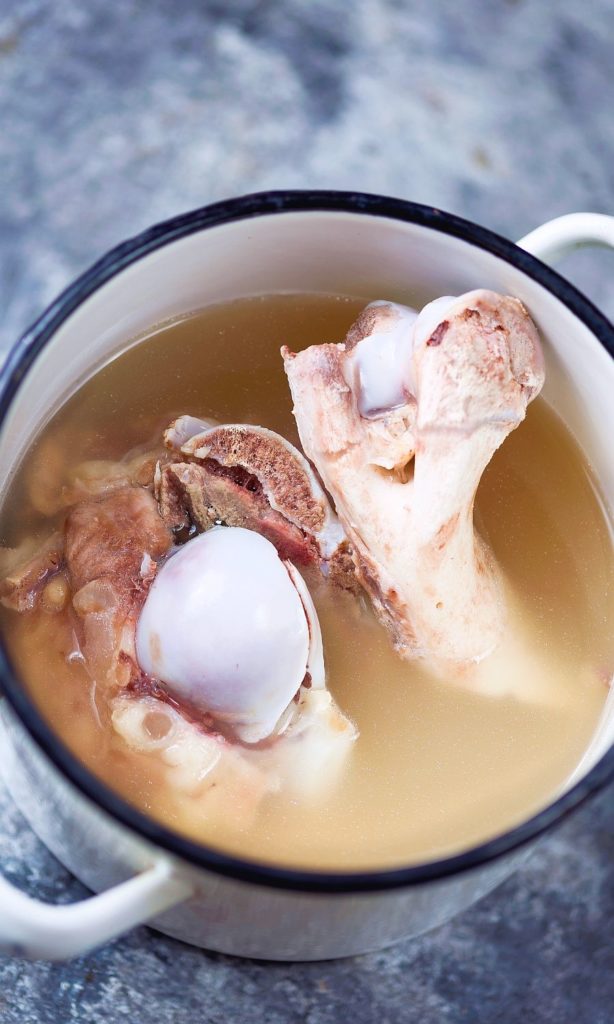Broth is a common ingredient in dog food used as a flavor enhancer, usually included in canned recipes. Broth in dog food mainly provides water and protein and many dog owners appreciate it as a wholesome and nutritious ingredient.
Contents
What is Broth in Dog Food?
Broth is included as a more nutritious and flavorful replacement for water in pet food.
Broth for dog food is made by simmering ingredients in water. This creates a nutrient-rich stock with protein components.
To define when water becomes broth, AAFCO states that broth must have a water-to-protein ratio of 135:1 or less[5].
So 135 parts water to a minimum of 1 part protein.
The AAFCO specifications are here to guarantee that manufacturers can not simply use “broth” as a fancy synonym for water that dog owners appreciate more than “sufficient water for processing“.
In theory, manufacturers can purchase dried broth powders or thickened broths, which they can then turn back into broth by adding water, as long as AAFCO specifications are met.

Types of Broth
The AAFCO ingredient glossary classifies two kinds of broth:
- Broth made from mammals or poultry
- Broth made from fish or seafood
But the definition varies only slightly between both types.
Mammal/Poultry Broth
Mammal or poultry broth is made from bones, parts, or muscle meat. It has to provide a protein content of at least 90% in dry matter. And it also has to be a named ingredient.
Examples include things like chicken broth or beef broth. It can also have a combined name like chicken and liver broth or salmon and chicken broth if several ingredients were used.
Fish Broth
Fish broth on the other hand can be made entirely from fish or fish parts. But can also be made from other marine animal products like bones, shells, parts, or meat.
Broth derived from marine sources has to provide a minimum of 80% crude protein in dry matter.
And it only has to have a descriptive name if there is one, e.g. salmon broth, tuna broth, or herring broth.
Bone Broth
Bone broth is a sub-type of stock that only uses bones and cartilage, e.g. fish bone broth, pork bone broth, chicken bone broth, etc.
Bone broth in dog food enjoys a very good reputation.
Homemade bone broth is commonly used as a meal topper, in yummy frozen treats, or as an ingredient in homemade dog treat recipes.

And because people like it so much it is an incredibly exciting market for pet food manufacturers…
Although there is no one bone broth recipe, it is considered a functional food. Some even call it a superfood.
By cooking bones, cartilage, tendons, and ligaments for long periods the collagen in these foods gets irreversibly split into smaller hydrolysate or simply gelatin.
Some people believe that bone broth provides their dogs with the amino acids necessary to make their own collagen.
But as with many dietary fads, there is no scientific evidence to support many of the health claims about bone broth[2].
Vegetable Broth
There is no definition for vegetable broth, which can be made from any plant-based flavors such as herbs and vegetables.
However, there does not appear to be a definition for a minimum nutrient content or maximum moisture content.
To us, this sounds like vegetable broth could be anything from water with a fancy name to a dehydrated bouillon cube.
Benefits of Broth
Broth is an extract that contains a variety of nutrients from the ingredients it was made of.
It can be a nutritious ingredient in dog food.
Broth can add amino acids, collagen, gelatin, chondroitin, or glucosamine which may help support joint health.
It can also add some trace minerals and other micronutrients.

But let’s be real, although it is often marketed for its nutritional value, broth in dog food is most often added as a flavoring agent.
Broth flavor is created by cooking down the protein matrix in marrow or cartilage into smaller protein fragments.
Broth can add a rich and savory taste to dog food, making it more appealing and palatable. Broth often adds umami dogs can taste[3,4].
This can be helpful for picky eaters or stimulate appetite in older dogs.
Broth in dog food can also help keep your dog hydrated and make it easier to switch from dry food to a tastier wet food.
Broth is by no means a controversial ingredient in dog food.
But there are some concerns to keep in mind when choosing dog food products that contain broth:
As always, we consider unspecified ingredients (fish broth, poultry broth) to be of lower quality than properly named ingredients (herring broth, chicken bone broth).
Broth in dog food is usually not made from whole food ingredients such as meat, bones, and vegetables, but from the bone and cartilage remains of animal carcasses.
But because broth can be made from so many different ingredients, it’s impossible to know what it contributes to a recipe.
And some commercial dog food products may use broths that are high in sodium or flavor enhancers that may not be as healthy.
And broth made from bones can be contaminated with lead[1] although still within the limits set for drinking water.
Further Reading
[1] Monro et al. The risk of lead contamination in bone broth diets. Medical Hypotheses. 2013. https://doi.org/10.1016/j.mehy.2012.12.026
[2] Amy Blaszyk. Taking Stock Of Bone Broth: Sorry, No Cure-All Here. NPR. 2015.
[3] Kumazawa et al. Canine taste nerve responses to umami substances. Physiology & Behavior. 1991. https://doi.org/10.1016/0031-9384(91)90197-V
[4] Zhang et al. Novel Umami Ingredients: Umami Peptides and Their Taste. J Food Sci. 2017. https://doi.org/10.1111/1750-3841.13576
[5] AAFCO Official Publication. Chapter 6. Free Access.
